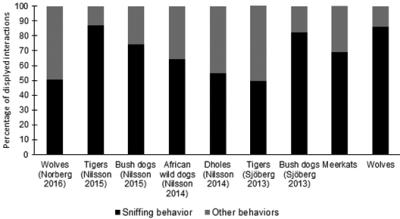Discussion
Comparisons with previously studied species
Sniffing was by far the most frequent behavior that the meerkats and all other species displayed toward the odorized logs, ranging from 50 to 87 percent of all observed behaviors.

By comparing the displayed interactions per animal towards the different odor stimuli, all six species showed the highest interest either towards the real mammalian blood and/or the meat odor component or the blood odor component.
When presented with odorized logs, the wolves (present study), the Amur tigers and the bush dogs (Nilsson 2015) displayed the highest number of interactions toward the odor of pig blood. The finding that the wolves and bush dogs interacted significantly more with the odor of pig blood compared to the meat odor component is not inconceivable with regards to the knowledge that both species are opportunistic predators that hunt for prey of various sizes (Zuercher et al. 2005, Mech & Boitani 2010).
When comparing the six different species, the meerkats displayed the highest number of interactions per animal (190) towards the odorized logs when considering the four odor stimuli combined. The comparison with results from previous studies on carnivore species and adding the meerkats from the present study further strengthens the idea that carnivore species perceive the blood odor component (trans-4,5-epoxy-(E)-2-decenal) as a “blood-like” odor. In five out of six species, the number of interactions toward odorized logs did not differ significantly between the blood odor component and the horse blood odor.
Conclusions
- The results of the present study demonstrate that the wolves displayed a significantly higher interest in logs odorized with pig blood compared to meat odor component (2-pentylfuran), fruity odor and the solvent. This result suggests that the wolves may not perceive the meat odor component as a prey-associated odor. Previous studies with other carnivore species but the same substance (2-pentylfuran) displayed a similar lack of interest in this meat odor component (Nilsson 2015).
-
The meerkats showed a high interest in two of the odor stimuli, the blood odor component (trans-4,5-epoxy-(E)-2-decenal) and the odor of horse blood. These results suggest that the meerkats perceive a single volatile component of blood (trans-4,5-epoxy-(E)-2-decenal) similarly as a complex mixture of real blood. This finding further supports the idea that the blood odor component may be perceived as an “blood-like” odor (Rachamadugu 2012) and possibly as a potential prey odor by carnivores in general.
-
Further, the present study demonstrates that odor stimuli presented on wooden logs can be an efficient and practical way to enrich the environment for captive animals such as meerkats and wolves.
Responsible for this page:
Director of undergraduate studies Biology
Last updated:
05/01/17
